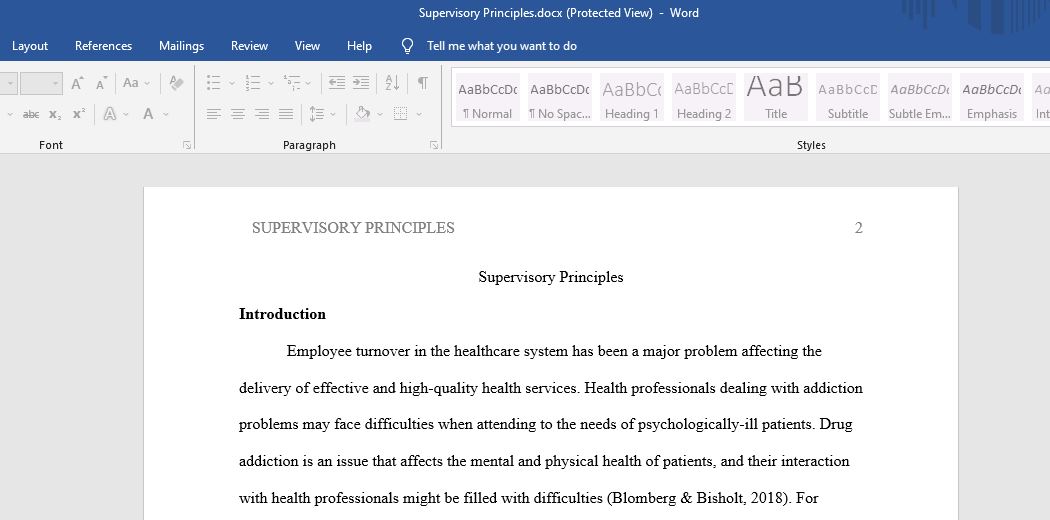Supervision and Program Management in Addiction Treatment.
SCENARIO 1: IMALEAVIN ADDICTION TREATMENT
Use the Capella University Library to complete the following:
- Read Garner and Hunter’s 2014 article, “Predictors of Staff Turnover and Turnover Intentions Within Addiction Treatment Settings: Change Over Time Matters,” from Substance Abuse: Research and Treatment, volume 8, pages 63–71.
- Read Knudsen, Ducharme, and Roman’s 2008 article, “Clinical Supervision, Emotional Exhaustion, and Turnover Intention: A Study of Substance Abuse Treatment Counselors in the Clinical Trials Network of the National Institute on Drug Abuse,” from Journal of Substance Abuse Treatment, volume 35, issue 4, pages 387–395.
Imaleavin is experiencing a high rate of staff turnover. Over the past five years, the annual staff turnover has increased from twenty to fifty percent as the agency and range of services has expanded. Imaleavin was founded by a partnership between a psychologist, Dr. Sylvia Smart, and an entrepreneur, Bob Money. When they opened their doors 10 years ago, they had a staff of 15. The agency focused on outpatient services with a variety of treatment groups held primarily in the evening. It was not particularly concerning when two or three staff members left for other opportunities each year.
Five years ago, Bob decided it was time to expand. Imaleavin’s reputation in the community was well established, and he was convinced that expanding the range of services offered would bring in more clients and revenue allowing them to purchase their own building and expand to offer a range of services from detox to extended recovery support. Dr. Smart reluctantly agreed, but insisted that they add a medical director to their staff, Dr. Rude, to oversee the medically supervised detox and pharmacological interventions. The agency and staff doubled in size in those five years.
Dr. Smart recognized that the expansion represented a significant change for the agency and several staff objected to the introduction of replacement therapy and left before the expansion even began. She anticipated that once new staff members committed to the new programs were recruited, the typical annual turnover rate of 20 percent would resume. Alarmingly, staff continued to leave at increasing rates each year for the next five years. Dr. Smart has convinced Bob that conducting a program evaluation is critical to understanding the turnover of staff and developing strategies to address it. Bob recognized that staff turnover damaged their reputation. The expense of bringing in outside consultants could be offset by reduced costs for staff training. Bob is wounded that his dream is not being embraced, but agreed to allow your staff to review data on hiring and retention to gain insights. He has also agreed to have your staff conduct exit interviews to gain data that may not be revealed by numbers.
- Identify fundamental supervisory issues that are relevant to your selected scenario. Differentiate these from other leadership concerns or external issues that might be present. Focus only on supervision-related issues for the purposes of this assignment.
- What kinds of supervisory models and methods that you have read about in this course are applicable to your scenario? Apply the identified models of supervision to the issues raised in the scenario. How would effective supervision help to mitigate the challenges presented?
- Consider the related ethical implications that must be addressed in the application of your identified model or method of supervision.
- Suggest appropriate administrative policies and procedures to employ in the implementation of these models or methods. What federal guidelines for the delivery of addiction treatment services (such as HIPAA) may be applicable?
- Written communication: Written communication must be grammatically correct and free of errors that detract from the overall message. Writing should be consistent with graduate level scholarship.
- APA formatting: Title page, main body, and references should be formatted according to APA (6th edition) style and formatting.
- Number of resources: Minimum of three scholarly resources.
- Length of paper: 3–4 typed, double-spaced pages. No abstract or table of contents is required.
- Font: Times New Roman, 12 point.
Answer preview:

word limit:993
